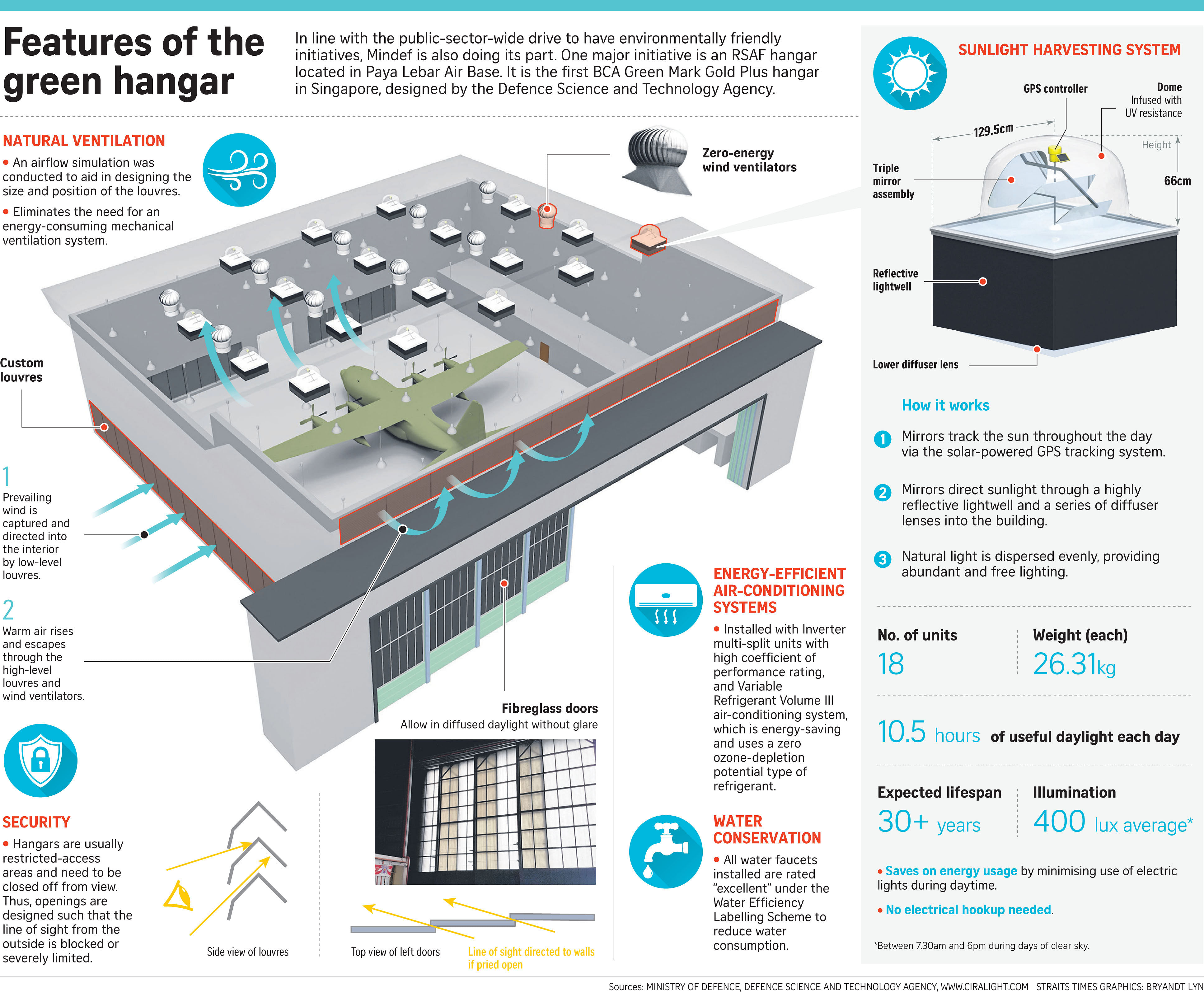Mindef showcases a different shade of green
It uses green building technologies, but they must be balanced with operational concerns
Sign up now: Get ST's newsletters delivered to your inbox
Follow topic:
Green, the colour of army fatigues, camouflage-streaked faces and dense jungle canopy, is almost synonymous with the military.
But as Singapore gears up for its Year of Climate Action - which will be launched soon - the Ministry of Defence wants to showcase a different shade of green: environmentally friendly military buildings.
One of them is the Republic of Singapore Air Force (RSAF) hangar in Paya Lebar Air Base.
Defence Minister Ng Eng Hen, in a Facebook post earlier this month, said: "Modern militaries use enormous energy to power their platforms - that's a fact.
"But wherever we can, we should try to reduce our consumption and become greener, and the most effective way to do this is through design."
Built in 2015, the RSAF hangar has water-and energy-efficient fixtures, and measures to promote the use of natural light instead of artificial light. It is also ventilated by natural airflow, instead of noisy, energy-expensive mechanical ventilation systems.
Such green building technologies are not new. But Mindef faces the unique challenge of having to balance green initiatives with operational concerns.
The hangar, for example, has to be fully enclosed so that the use of classified equipment or covert operations conducted are not compromised, said Military Expert (ME) 4 Dave Singh, 31, from the RSAF 807 Squadron at Paya Lebar Air Base.
Key to this balancing act is design, which the Defence Science and Technology Agency (DSTA) does with input from the Singapore Armed Forces.
DSTA principal architect Aw Boon Seong, 40, had collaborated with the RSAF for the design of the green hangar. He said: "One of the challenges we faced was finding out how to balance this security concern with the need to add in natural light and ventilation."
This was done in a number of ways. Translucent fibreglass panels were incorporated into the thick doors of the hangar to let in sunlight. The hangar also uses a lighting system that can track the movement of the sun across the sky, which helps to reflect sunlight into the interior.
For ventilation, the hangar was designed to tap the natural movement of air. An airflow simulation was first done to help engineers identify "hot spots", and where louvres - overlapping steel slats which let in light and air - should be placed to help heat dissipate.

In civilian developments, there are gaps between the louvres through which the interior can be seen. But for the hangar, the DSTA engineers had to design them in a way that would close off the interior completely.
Dr Ng said: "Security is maintained as the hangar is still fully enclosed. The result? Reduced electricity needs by a fourth!"
Energy savings aside, ME4 Singh said the green measures also made working within the hangar a more pleasant experience, and could help boost morale among the crew.
"In a conventional hangar, it may get stuffy despite the mechanical ventilator, which tends to be noisy. Working in a green hangar is cooler, brighter and quieter, which boosts concentration and reduces fatigue," he said.
Another military green building is a boat shed at the Republic of Singapore Navy's (RSN) Changi Naval Base, which is used for the storage and maintenance of unmanned surface vessels and specialised marine craft.
The boat shed is powered by renewable energy from the sun, which accounts for some 94 per cent of the building's total energy demand.
Mr Charles Chan, 40, programme manager for building and infrastructure at DSTA, said that as part of ongoing green efforts for Changi Naval Base, engineers will continue to explore opportunities to increase the use of solar energy to 100 per cent so that the building does not need to draw power from the grid.
Reducing overall energy demand by using energy-efficient LED lighting and tapping sunlight and natural airflow for ventilation is key to this, he added.
These measures have allowed the RSN to reap daily energy savings of 200kWh - equivalent to the daily energy requirements of 21 three-room flats.
The boat shed has a rainwater-harvesting system which saves water too. The system collects rainwater on the roof, which is used for cooling engines during vessel tests. The used water is then channelled into an underground water tank for reuse in subsequent tests.
Without such a system, about 100 cubic m of piped potable water will be used each week for such tests, said RSN's Mr Jason Chong, 58, who heads the infrastructure development branch of the Naval Plans Department. He added: "Piped seawater will cause corrosion to the pipes, while (using) potable water is wasteful and expensive, so rainwater is the best cost-saving option."

